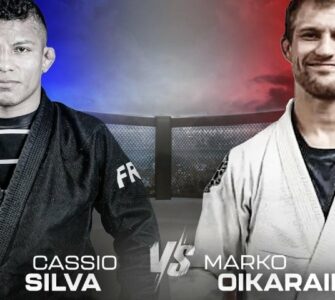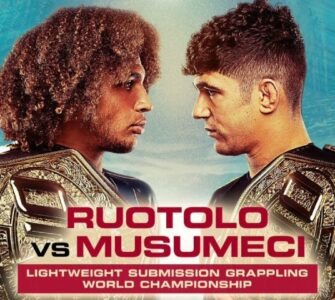Article sent to us on our contact form. Photo is not of author.
Oh you’re a woman doing BJJ? You must be doing it for rape prevention*.
I’m sorry, what?
Where does this kind of bigotry come from? Just because You are in a martial arts class, am I to assume you beat up people in your spare time because it’s a men thang to do?
Why is there a preconception that I shouldn’t be in it for the sports aspect of it?
*While I realize this is what’s often referred to as self-defense I choose to use the term as it was spoken to me verbatim multiple times by different people because it really is That appalling Fact remains that as mixed martial arts continue to grow, marketers are challenged with finding acceptable ways to market inherently violent sport.
The inclusion of women as participants further complicates the issue in some researcher’s minds. Women have been competing professionally since the mid 1990s, but participation was mostly confined to Japanese promotions. The first sanctioned women’s bout in the United States wasn’t until 2002.
The first major promotion of a women’s bout was by Strikeforce featuring Gina Carano in December of 2006 (Savage & Mandel, 2006). In the last two years, women’s participation in MMA has experienced exponential growth.
It’s worth mentioning that two most recent seasons of UFC’s Ultimate Fighter reality series featured two female coaches (Rousey and Tate) and an all-female fight cast. This is the first time women were represented as coaches and fighters in series’ 22 seasons. Viewership for series experienced about a 20% spike on weeks when the women fought (“Fox looks at TUF ratings differently,” 2013; Iole, 2013).
Shannon Knapp, president of the all-women’s Invicta Fighting Championship argues that it should not matter if the fighter is male or female arguing that true fans are not gender biased. The notion that fans are not gender biased mirrors research on MMA fighters, which also suggests participation in MMA defies gender norms (Channon & Jennings, 2014).
I can’t help but wonder would that be true on a small scale – let’s say if you questioned the attitudes of members of any bjj academy.
*I only say bjj because that’s what my experience reflects.
In terms of ratings, it appears the sport is catching on with younger women. A 2012 ESPN sports poll showed 44% of women ages 18-34 were MMA fans, while only 28% of women ages 35-54 were fans. While the number still lags behind the number of male fans industry specialists suggest women make up upto 30% of the MMA fan base (Greene, 2011; “UFC 154 Audience Demographics,” 2012).
Despite its growing popularity women’s participation in violent combat sports may conjure an unsavory depiction of domestic violence and abuse thus the potential exists to alienate a growing and avid fan base, researchers suggest.
In the past, I’ve never felt comfortable enough to let my ultracompetitive combative side show outside the bounds of my family because I didn’t want to be perceived as more of a tomboy than I already was. It so happens I was ready to embrace the fighter within because it was the part that kept me alive through some very harsh times. So I found myself in a room with a single girl and another 30 guys. Being quite liberal I didn’t think anything of it. I came to learn, to be exhausted and to ache in new and inventive ways. But most of the experienced men there have since approached me saying they were sure I wouldn’t last. I’m still not sure whether I should be insulted.
Number of them also made sexual violence references while drilling with me. They didn’t have ulterior motives, in fact I’m sure a couple of them thought it would be a superb incentive for me to drill harder but I was just mightily pissed off. Do You work out so you wouldn’t be a handy target for predators of the world?
I mean, sure… self-defense aspect of bjj is used in marketing as means to get as many people to sign up as possible but are we actually expecting those people to ever become black belts (or purple at least)? The Gracies will gladly tell you that only between 0 and 1 percent of students ever reach black belt level. How many people in that 1% do you think are trying to prevent the worst case scenario and how many are just looking to learn one day at a time?
Bad things happen to everybody and yes – statistically speaking they’re more likely to happen to women but why would any of us focus on the worst case scenario? It’s not only negative but it’s also harassment.
Not to mention that a couple of guys remain convinced that I’m objectifying them on my occasional breaks between rolls. Really speaks volumes. God bless patriarchy! If only I could lovingly gaze at hairy twisted bottoms without actually participating…
I am really bothered by the idea that it’s socially acceptable for me to be involved with a martial art only as the means for defending myself against an assailant. Historically, sport has been marked as a male domain through which young men learn to be aggressive, tough, dominant and even violent. Even going so far as 1972 women’s participation in sport was limited to little more than backyard games, but why is it so strange that I might like to step out of the traditional role in 2015?
Maybe I enjoy clearing my head for an hour every night of the week, or maybe I’m selfish and seeking means to keep developing my brain. Martial arts are a proven instrument in improving your brain by the way. Learning new movements, and developing schemes in combination with exercise will lead your neurons to develop new connections and it will improve the vascularization in your brain. It also makes me mighty mellow and sated. Pardon the cliché but if jiu-jitsu saved your life, why can’t it save mine?
Truth is the violent nature of a sport defies traditional gender norms (Messner, 2007). On the other hand, if I was recreationally involved in a sport allowing me to remain true to stereotyped expectations of femininity like gymnastics or ice skating would you think I was doing it for me or to improve my sex appeal or sex related flexibility? The insult really is in the eyes of the beholder.
literature
Channon, A. (2013). ‘Do you hit girls?’ Some striking moment in the career of a male martial artist. In R. Sanchez Garcia, 8c D. C. Spencer (Eds.), Fighting scholars: Habitus and ethnographies of martial arts and combat sports (pp. 95-110). London, UK: Anthem Press.
Channon, A., 8c Jennings, G. (2014). Exploring embodiment through martial arts and combat sports: A review of empirical research. Sport in Society, 17, 773-789.
Greene, D. (2011, October 20). The demographics of MMA: Know the combat sports industry. Examiner.com. Retrieved from http://www.examiner.com/article/the-demographics-of-mma-knowthe-combat-sports-industry
Greenwell, T, Hancock, M, Simmons, J, & Thorn, D 2015, ‘The Effects of Gender and Social Roles on the Marketing of Combat Sport’, Sport Marketing Quarterly, 24, 1, pp. 19-29, Business Source Premier, EBSCOhost, viewed 24 October 2015.

















